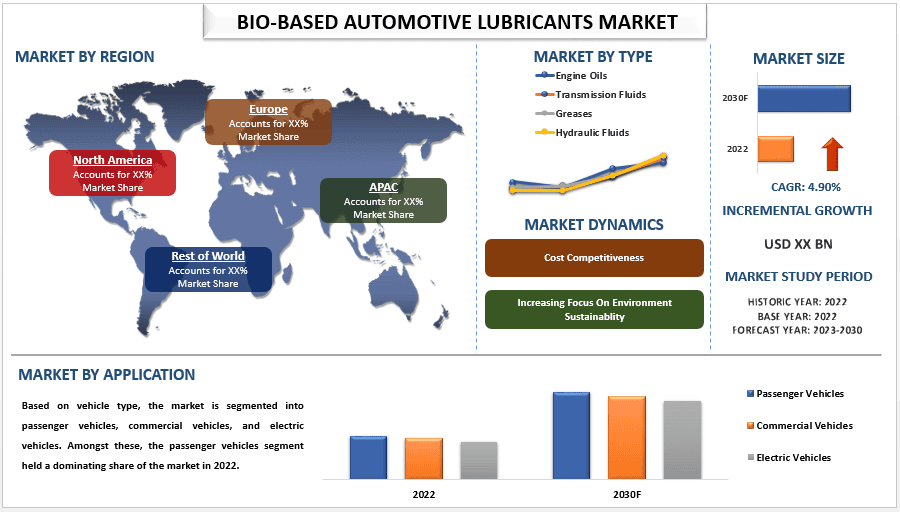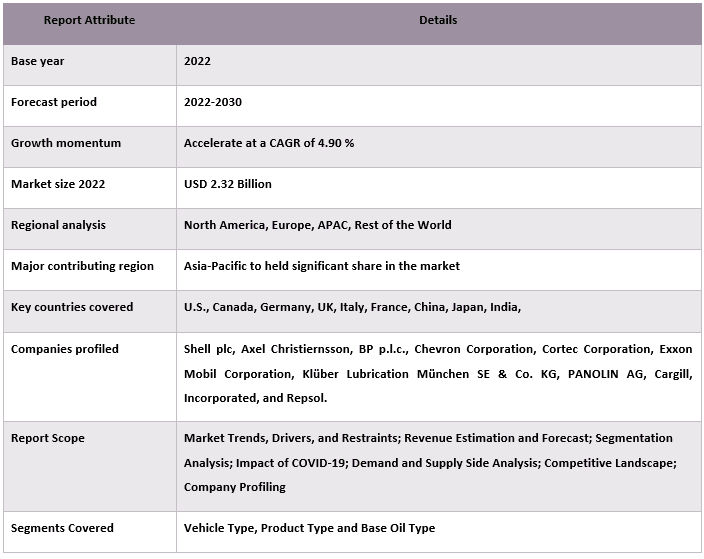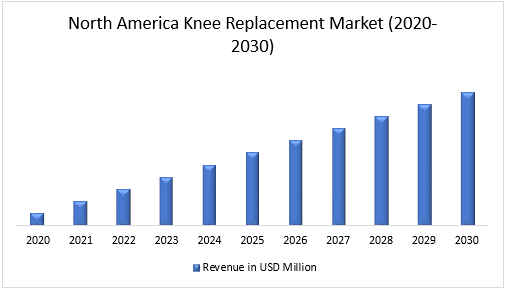- Home
- About Us
- Industry
- Services
- Reading
- Contact Us
Bio-Based Automotive Lubricants Market: Current Analysis and Forecast (2023-2030)
Emphasis on Product Type (Engine Oils, Transmission Fluids, Hydraulic Fluids, Greases, and Others), Base Oil Type (Vegetable Oil, Animal Fat, Synthetic Esters, and Bio-Based Polyalphaolefins), Vehicle Type (Passenger Vehicles, Commercial Vehicles, and Electric Vehicles) and Region/Country

The Bio-Based Automotive Lubricants Market” report, the global market was valued at USD 2.32 billion in 2022, growing at CAGR of 4.90 % during the forecast period from 2022 – 2030. The global bio-based automotive lubricants market is revving up, driven by a growing chorus of environmental concerns, technological advancements, and economic factors. Climate change anxieties are pushing for sustainable alternatives, and bio-based lubricants offer a dramatic carbon footprint reduction compared to their fossil-based counterparts. Advancements in bio-based base oils have created high-performance options that rival or even surpass traditional lubricants, silencing concerns about their limitations. Increased research and development is further expanding the range of applications and enhancing their viability. As costs continue to drop thanks to economies of scale and technological improvements, bio-based lubricants are becoming more accessible to a wider audience.
Some of the major players operating in the market are Shell plc, Axel Christiernsson, BP p.l.c., Chevron Corporation, Cortec Corporation, Exxon Mobil Corporation, Klüber Lubrication München SE & Co. KG, PANOLIN AG, Cargill, Incorporated, and Repsol. Several M&As along with partnerships have been undertaken by these players to facilitate customers with hi-tech and innovative products/technologies.
Insights Presented in the Report
“Amongst vehicle type, the electric vehicles sales segment held significant growth in the market in 2022.”
Based on vehicle type, the market is segmented into passenger vehicles, commercial vehicles, and electric vehicles. Amongst these, the electric vehicles held significant growth in the market in 2022. Bio-based lubricants are known for their good performance characteristics, including improved wear protection, thermal stability, and corrosion resistance. These properties are important for the efficient functioning of electric vehicle components, such as electric motors and batteries. In addition, bio-based lubricants are often formulated to be compatible with the materials used in electric vehicles, ensuring optimal performance and longevity.
“Amongst product type, the transmission fluids held a significant growth in the market. ’’ Based on product type, the market is segmented into engine oils, transmission fluids, hydraulic fluids, greases and others. Among these, the transmission fluids segment held a significant growth of the bio-based automotive lubricants market in 2022 because automatic tube cleaning systems help maintain the efficiency of heat exchangers in power generation plants by preventing fouling and scaling. These systems improve heat transfer, reduce energy consumption, and enhance overall performance, making them valuable for power generation applications. Power generation plants benefit from reduced maintenance and operational expenses, leading to cost savings in the long run.
“North America held a significant share in the bio-based automotive lubricants market in 2022.”
North America, especially the United States, has implemented strict environmental regulations to reduce carbon emissions and promote sustainable practices. As a result, the demand for bio-based products, including automotive lubricants, has increased. The region has seen significant advancements in bio-based lubricant technologies, such as the development of high-performance additives and innovative manufacturing processes. This has improved the quality and performance of bio-based automotive lubricants, thus driving their market share. Furthermore, increasing awareness among consumers about the environmental impact of conventional petroleum-based lubricants has led to a shift in preferences towards sustainable alternatives. This trend has further fueled the demand for bio-based automotive lubricants in North America.
Bio-Based Automotive Lubricants Market Report Coverage

Reasons to buy this report:
- The study includes market sizing and forecasting analysis validated by authenticated key industry experts.
- The report presents a quick review of overall industry performance at one glance.
- The report covers an in-depth analysis of prominent industry peers with a primary focus on key business financials, product portfolios, expansion strategies, and recent developments.
- Detailed examination of drivers, restraints, key trends, and opportunities prevailing in the industry.
- The study comprehensively covers the market across different segments.
- Deep dive regional level analysis of the industry.
Customization Options:
The global bio-based automotive lubricants market can further be customized as per the requirement or any other market segment. Besides this, UMI understands that you may have your own business needs, hence feel free to connect with us to get a report that completely suits your requirements.
Table of Content
Research Methodology for the Bio-Based Automotive Lubricants Market Analysis (2022-2030)
Analyzing the historical market, estimating the current market, and forecasting the future market of the global bio-based automotive lubricants market were the three major steps undertaken to create and analyze the adoption of PTFE fabrics in major regions globally. Exhaustive secondary research was conducted to collect the historical market numbers and estimate the current market size. Secondly, to validate these insights, numerous findings and assumptions were taken into consideration. Moreover, exhaustive primary interviews were also conducted, with industry experts across the value chain of the global bio-based automotive lubricants market. Post assumption and validation of market numbers through primary interviews, we employed a top-down/bottom-up approach to forecasting the complete market size. Thereafter, market breakdown and data triangulation methods were adopted to estimate and analyze the market size of segments and sub-segments of the industry pertains to. Detailed methodology is explained below:
Analysis of Historical Market Size
Step 1: In-Depth Study of Secondary Sources:
Detail secondary study was conducted to obtain the historical market size of the bio-based automotive lubricants market through company internal sources such as annual reports & financial statements, performance presentations, press releases, etc., and external sources including journals, news & articles, government publications, competitor publications, sector reports, third-party database, and other credible publications.
Step 2: Market Segmentation:
After obtaining the historical market size of the bio-based automotive lubricants market, we conducted a detailed secondary analysis to gather historical market insights and share for different segments & sub-segments for major regions. Major segments are included in the report as vehicle type, product type and base oil. Further country-level analyses were conducted to evaluate the overall adoption of testing models in that region.
Step 3: Factor Analysis:
After acquiring the historical market size of different segments and sub-segments, we conducted a detailed factor analysis to estimate the current market size of the bio-based automotive lubricants market. Further, we conducted factor analysis using dependent and independent variables such as vehicle type, product type and base oil of the bio-based automotive lubricants market. A thorough analysis was conducted of demand and supply-side scenarios considering top partnerships, mergers and acquisitions, business expansion, and product launches in the bio-based automotive lubricants market sector across the globe.
Current Market Size Estimate & Forecast
Current Market Sizing: Based on actionable insights from the above 3 steps, we arrived at the current market size, key players in the global bio-based automotive lubricants market, and market shares of the segments. All the required percentage shares split, and market breakdowns were determined using the above-mentioned secondary approach and were verified through primary interviews.
Estimation & Forecasting: For market estimation and forecast, weights were assigned to different factors including drivers & trends, restraints, and opportunities available for the stakeholders. After analyzing these factors, relevant forecasting techniques i.e., the top-down/bottom-up approach were applied to arrive at the market forecast for 2028 for different segments and sub-segments across the major markets globally. The research methodology adopted to estimate the market size encompasses:
- The industry’s market size, in terms of revenue (USD) and the adoption rate of the bio-based automotive lubricants market across the major markets domestically
- All percentage shares, splits, and breakdowns of market segments and sub-segments
- Key players in the global bio-based automotive lubricants market in terms of products offered. Also, the growth strategies adopted by these players to compete in the fast-growing market.
Market Size and Share Validation
Primary Research: In-depth interviews were conducted with the Key Opinion Leaders (KOLs) including Top Level Executives (CXO/VPs, Sales Head, Marketing Head, Operational Head, Regional Head, Country Head, etc.) across major regions. Primary research findings were then summarized, and statistical analysis was performed to prove the stated hypothesis. Inputs from primary research were consolidated with secondary findings, hence turning information into actionable insights.
Split of Primary Participants in Different Regions

Market Engineering
The data triangulation technique was employed to complete the overall market estimation and to arrive at precise statistical numbers for each segment and sub-segment of the global bio-based automotive lubricants market. data was split into several segments & sub-segments after studying various parameters and trends in the areas of vehicle type and technology in the global bio-based automotive lubricants market.
The main objective of the Global Bio-Based Automotive Lubricants Market Study
The current & future market trends of the global bio-based automotive lubricants market were pinpointed in the study. Investors can gain strategic insights to base their discretion for investments on the qualitative and quantitative analysis performed in the study. Current and future market trends determined the overall attractiveness of the market at a regional level, providing a platform for the industrial participant to exploit the untapped market to benefit from a first-mover advantage. Other quantitative goals of the studies include:
- Analyze the current and forecast market size of the bio-based automotive lubricants market in terms of value (USD). Also, analyze the current and forecast market size of different segments and sub-segments.
- Segments in the study include areas of the as vehicle type, product type and base oil.
- Define and analyze the regulatory framework for the bio-based automotive lubricants
- Analyze the value chain involved with the presence of various intermediaries, along with analyzing customer and competitor behaviors of the industry.
- Analyze the current and forecast market size of the bio-based automotive lubricants market for the major region.
- Major countries of regions studied in the report include Asia Pacific, Europe, North America, and the Rest of the World
- Company profiles of the bio-based automotive lubricants market and the growth strategies adopted by the market players to sustain in the fast-growing market.
- Deep dive regional level analysis of the industry
Frequently Asked Questions FAQs
Q1: What is the current market size and growth potential of the global bio-based automotive lubricants Market?
Q2: What are the driving factors for the growth of the global bio-based automotive lubricants market?
Q3: Which segment has the largest share of the global bio-based automotive lubricants market by vehicle type?
Q4: Which region will dominate the global bio-based automotive lubricants Market?
Q5: Who are the key players operating in the global bio-based automotive lubricants market?
Related Reports
Customers who bought this item also bought










